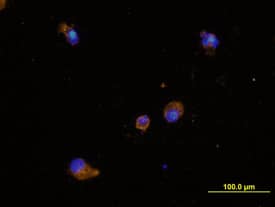Human Dectin-1/CLEC7A Antibody
R&D Systems, part of Bio-Techne | Catalog # MAB1859


Key Product Details
Species Reactivity
Validated:
Cited:
Applications
Validated:
Cited:
Label
Antibody Source
Product Specifications
Immunogen
Thr66-Met201
Accession # NP_072092
Specificity
Clonality
Host
Isotype
Endotoxin Level
Scientific Data Images for Human Dectin-1/CLEC7A Antibody
Dectin‑1/CLEC7A in Human Dendritic Cells.
Dectin-1/CLEC7A was detected in immersion fixed mature human dendritic cells using Mouse Anti-Human Dectin-1/CLEC7A Monoclonal Antibody (Catalog # MAB1859) at 10 µg/mL for 3 hours at room temperature. Cells were stained using the NorthernLights™ 557-conjugated Anti-Mouse IgG Secondary Antibody (yellow; Catalog # NL007) and counterstained with DAPI (blue). View our protocol for Fluorescent ICC Staining of Non-adherent Cells.Applications for Human Dectin-1/CLEC7A Antibody
Blockade of Receptor-ligand Interaction
CyTOF-ready
Flow Cytometry
Sample: Human whole blood monocytes
Immunocytochemistry
Sample: Immersion fixed human peripheral blood mononuclear cells and mature human dendritic cells
Reviewed Applications
Read 5 reviews rated 4.8 using MAB1859 in the following applications:
Formulation, Preparation, and Storage
Purification
Reconstitution
Formulation
Shipping
Stability & Storage
- 12 months from date of receipt, -20 to -70 °C as supplied.
- 1 month, 2 to 8 °C under sterile conditions after reconstitution.
- 6 months, -20 to -70 °C under sterile conditions after reconstitution.
Background: Dectin-1/CLEC7A
Dectin-1, also known as CLEC7A and the beta-glucan receptor, is a 33 kDa type II transmembrane C-type lectin that participates in the innate immune response to fungal pathogens. Although Dectin-1 structurally resembles other CLEC molecules, it binds its ligands in a calcium-independent manner (1, 2). Mature human Dectin-1 consists of a short N-terminal ITAM-containing cytoplasmic tail, a transmembrane segment, and a C-terminal stalk with a carbohydrate recognition domain (CRD) in the extracellular domain (3, 4). Alternate splicing generates one major splice form that lacks the stalk region (3‑5). This isoform is expressed on the surface of monocytes, macrophages, myeloid DC, neutrophils, eosinophils, B cells, and CD4+ T cells (6). The CRD selectively binds beta-glucan polymers, a major component of yeast and mycobacterial cell walls (5‑7). Yeast beta-glucan is accessible to Dectin‑1 only during the process of cell budding. Dectin-1 does not recognize the filamentous form of yeast (8). Dectin-1 mediates the phagocytosis of zymosan particles and intact yeast (8‑10). In the membrane, Dectin-1 colocalizes with TLR2 in the presence of zymosan, and the two receptors cooperate in ligand recognition and the propagation of proinflammatory signaling (9, 11‑13). Dectin-1 also interacts with tetraspanin CD37. This increases its stability on the cell membrane and inhibits ligand-induced signaling (14). Dectin-1 knockout mice show increased susceptibility to pathogenic infection (15‑16). The CRD of human Dectin-1 shares 77%, 60%, and 60% amino acid (aa) sequence identity with that of bovine, mouse and rat Dectin-1, respectively. It shares 29%‑39% aa sequence identity with the CRD of other subgroup members, including CLEC-1, CLEC-2, CLEC9A, CLEC12B, LOX-1, and MICL.
References
- Kanazawa, N. (2007) J. Dermatol. Sci. 45:77.
- Brown, G.D. (2006) Nat. Rev. Immunol. 6:33.
- Hernanz-Falcon, P. et al. (2001) Immunogenetics 53:288.
- Yokota, K. et al. (2001) Gene 272:51.
- Willment, J.A. et al. (2001) J. Biol. Chem. 276:43818.
- Willment, J.A. et al. (2005) Eur. J. Immunol. 35:1539.
- Palma, A.S. et al. (2006) J. Biol. Chem. 281:5771.
- Gantner, B.N. et al. (2005) EMBO J. 24:1277.
- Gantner, B.N. et al. (2003) J. Exp. Med. 197:1107.
- Kennedy, A.D. et al. (2007) Eur. J. Immunol. 37:467.
- Brown, G.D. et al. (2003) J. Exp. Med. 197:1119.
- Yadav, M. and J.S. Schorey (2006) Blood 108:3168.
- Suram, S. et al. (2006) J. Biol. Chem. 281:5506.
- Meyer-Wentrup, F. et al. (2007) J. Immunol. 178:154.
- Saijo, S. et al. (2007) Nat. Immunol. 8:39.
- Taylor, P.R. et al. (2007) Nat. Immunol. 8:31.
Alternate Names
Gene Symbol
UniProt
Additional Dectin-1/CLEC7A Products
Product Documents for Human Dectin-1/CLEC7A Antibody
Product Specific Notices for Human Dectin-1/CLEC7A Antibody
For research use only